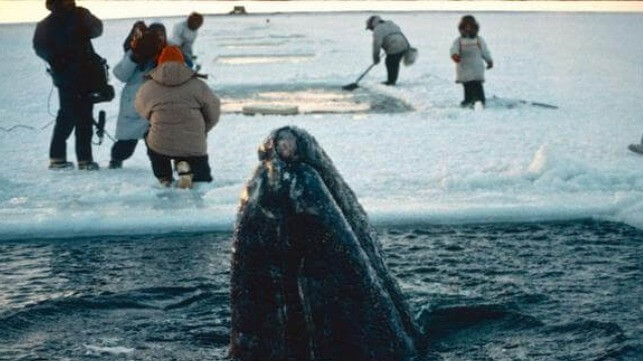"Operation Breakthrough": Remembering a Rare Thaw in the Cold War

On October 7, 1988, 'Operation Breakthrough' was a rare US-Soviet cooperation to free three juvenile gray whales that became trapped in pack-ice in the Beaufort Sea near Point Barrow, Alaska. The whales had become disoriented, confused, and could barely breathe between the sheets of thick ice. A $1 million US-Soviet joint effort commenced at the height of the Cold War, when cooperation was practically unheard-of.
Inupiaq hunter Roy Ahmaogak discovered the 3 whales, and immediately used a chainsaw to cut a path in the ice leading to open water. But temperatures were so brutally cold that the ice reformed overnight, so villagers used de-icing pumps to keep the path from refreezing. A Sikorsky S-64 Skycrane heavylift helicopter punched holes in the ice using a 5-ton hammer. The whales were given Inuit names Putu, Siku, and Kanik (English names Bonnet, Crossbeak, and Bone).
Rescuers borrowed a barge from Prudhoe Bay to break the ice and clear a path, but the barge became locked in. International media started arriving at the site. The US National Oceanic & Atmospheric Administration sent a team of whale biologists, and oil companies in the North Slope Field lent their resources to help. The U.S. Department of State requested the help of two icebreakers from the Soviet Union. The 'Vladimir Arseniev' and the 'Admiral Makarov' immediately responded.
'Admiral Makarov' broke apart an ice ridge 400 yards wide and 30 feet thick. 'Vladimir Arseniev' cleared the icy rubble to create a path for the remaining two whales to escape. But when the whales attempted to take the exit path, swarms of journalists scared them, and they swam back. Jagged ice from the rescue effort cut the whales, bloodying the water.
The youngest whale (Kanik) died on October 21, at 9 months of age. Putu and Siku swam away unseen, and Operation Breakthrough was declared a success. However, the whales were reported to be in very poor health, and it is unknown whether they survived.
Gray whales make an annual 10,000-mile migration from their feeding grounds in the Bering Sea to the lagoons of Mexico's Baja California. The whales usually leave Alaska before the sea ice can trap them near the coastal waters. These whales made a mistake by delaying their departure, and scientists criticised the effort as 'disrupting natural mortality.' But at a time of increasing anti-whaling sentiment, Operation Breakthrough occurred because of human's deep affinity for the wellbeing of whales.
 Cameron Livingstone MNI is the secretary of the South Eastern Australia Branch of The Nautical Institute, which covers the region of New South Wales and the Australian Capital Territory. The Institute's aim is to promote professionalism, best practice and safety throughout the maritime industry and to represent the interests of its members.
Cameron Livingstone MNI is the secretary of the South Eastern Australia Branch of The Nautical Institute, which covers the region of New South Wales and the Australian Capital Territory. The Institute's aim is to promote professionalism, best practice and safety throughout the maritime industry and to represent the interests of its members.
This article appears courtesy of the author and may be found in its original form here.
The opinions expressed herein are the author's and not necessarily those of The Maritime Executive.

